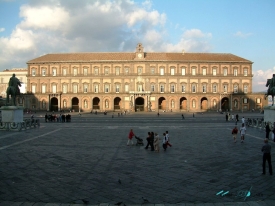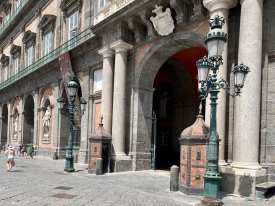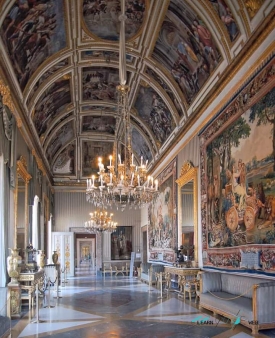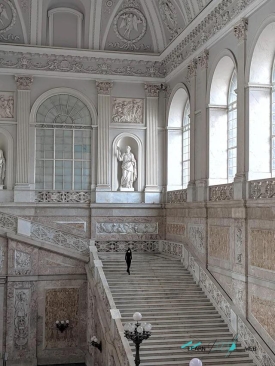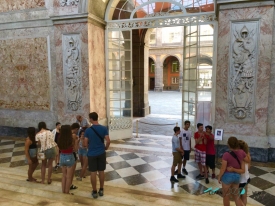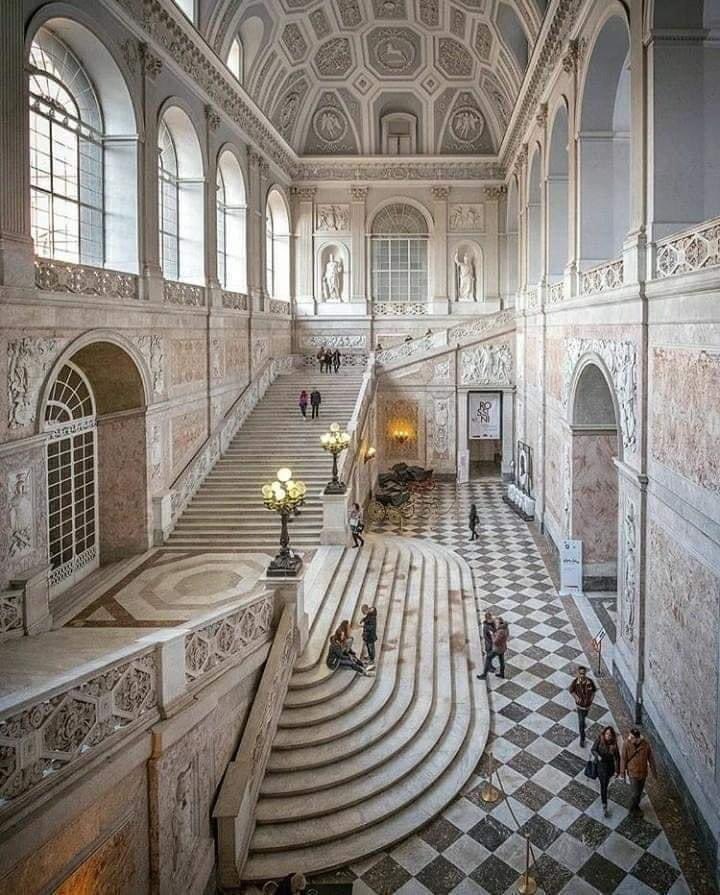
Imposing and majestic, the Royal Palace of Naples stands as one of the city's principal architectural and artistic icons. Erected in the early 17th century on the orders of the Spanish Viceroy Fernando Ruiz de Castro, this royal palace has become an essential tourist destination thanks to its rich history, its dazzling interiors, and its spectacular hanging gardens. Exploring its halls and chambers is to immerse oneself in a journey through the centuries, exploring the legacy of the viceroys, kings, and princes who have inhabited this jewel of the Italian Renaissance.
Over the centuries, the palace was modified and embellished by successive generations of architects, such as Gaetano Genovese, Luigi Vanvitelli, and Francesco Antonio Picchiatti, who gave it its current appearance. It served as the seat of the Spanish and Austrian viceroys until 1734, when it passed into the hands of the Bourbon dynasty, who left their particular stamp on the royal apartments. After the unification of Italy in 1861, the Palace served as a residence for the House of Savoy until it was ceded to the State in 1919.
Divided vertically by pilasters and horizontally by cornices, the façade displays the three classical orders: Tuscan on the ground floor, Ionic on the first floor, and Corinthian on the second. Originally, the lower floor had a row of porticos, an innovative solution to allow the public to stroll under cover. However, in 1753 these arcades were closed on the orders of Luigi Vanvitelli due to structural problems, and niches were opened in their place to house statues of Neapolitan monarchs.
Other façades, such as the one facing Piazza Trieste e Trento and the one overlooking the sea, were completed in the 19th century, following the same architectural language and creating a harmonious and majestic ensemble.
But undoubtedly, the true treasure of the Royal Palace is found in the dazzling Royal Apartments, located on the piano nobile (noble floor). These luxurious quarters, used over the centuries as a residence and halls of representation for viceroys, kings, and princes, have preserved their sumptuous original decoration intact.
The various rooms exhibit exquisite art collections, mostly from the Farnese and Bourbon collections, as well as works by 17th-century Neapolitan artists. The furniture, in Rococo and Baroque styles, was created by renowned cabinetmakers of the city between the 18th and 19th centuries. These interiors are complemented by tapestries, porcelain, clocks, sculptures, and other artistic and artisanal objects.
One of the most impressive spaces is the Palatine Chapel, of grand size and lavishly decorated, whose ornamentation was not completed until 1644. The delicate Court Theater, a recently restored performance space, also stands out.
Distributed across various levels and terraces, the gardens house a varied collection of plants, fountains, and statues that create an environment of great beauty and tranquility, in pleasant contrast with the lively pulse of the streets of Naples.
In 1997, UNESCO recognized the exceptional historical, artistic, and architectural value of the Royal Palace by including it in the World Heritage List. This accolade reaffirms the palace's role as one of the greatest exponents of Italy's cultural legacy and makes it an essential destination for anyone visiting the fascinating city of Naples.
Exploring the sumptuous apartments, admiring the majesty of its facades, and immersing oneself in the beauty of its hanging gardens is to delve into centuries of Neapolitan history. The Royal Palace is much more than an imposing royal residence: it is a true treasure that captivates all those who have the opportunity to discover it.
The History of a Royal Palace
The construction of the Royal Palace dates back to the year 1600, when Viceroy Fernando Ruiz de Castro commissioned the prestigious architect Domenico Fontana to build a new royal residence. The idea was to create a sumptuous dwelling that could host the expected visit of the Spanish monarch Philip III, although he would never set foot in Naples.Over the centuries, the palace was modified and embellished by successive generations of architects, such as Gaetano Genovese, Luigi Vanvitelli, and Francesco Antonio Picchiatti, who gave it its current appearance. It served as the seat of the Spanish and Austrian viceroys until 1734, when it passed into the hands of the Bourbon dynasty, who left their particular stamp on the royal apartments. After the unification of Italy in 1861, the Palace served as a residence for the House of Savoy until it was ceded to the State in 1919.
An Imposing and Majestic Façade
The magnificence of the Royal Palace is manifested in its impressive main façade, which extends 169 meters across Piazza del Plebiscito. Built between 1600 and 1616, this façade presents an architectural style that blends late-Renaissance and Mannerist elements, with a modular and symmetrical composition that gives it an almost infinite appearance.Divided vertically by pilasters and horizontally by cornices, the façade displays the three classical orders: Tuscan on the ground floor, Ionic on the first floor, and Corinthian on the second. Originally, the lower floor had a row of porticos, an innovative solution to allow the public to stroll under cover. However, in 1753 these arcades were closed on the orders of Luigi Vanvitelli due to structural problems, and niches were opened in their place to house statues of Neapolitan monarchs.
Other façades, such as the one facing Piazza Trieste e Trento and the one overlooking the sea, were completed in the 19th century, following the same architectural language and creating a harmonious and majestic ensemble.
The Luxurious Royal Apartments
After crossing the impressive main portal, visitors are captivated by the grand staircase, considered one of the most beautiful in Europe. Originally designed by Domenico Fontana, it was remodeled in 1858 by Gaetano Genovese in an elegant Neoclassical style. The hall that houses this staircase features a lining of fine marbles extracted from the quarries of the former Kingdom of the Two Sicilies.But undoubtedly, the true treasure of the Royal Palace is found in the dazzling Royal Apartments, located on the piano nobile (noble floor). These luxurious quarters, used over the centuries as a residence and halls of representation for viceroys, kings, and princes, have preserved their sumptuous original decoration intact.
The various rooms exhibit exquisite art collections, mostly from the Farnese and Bourbon collections, as well as works by 17th-century Neapolitan artists. The furniture, in Rococo and Baroque styles, was created by renowned cabinetmakers of the city between the 18th and 19th centuries. These interiors are complemented by tapestries, porcelain, clocks, sculptures, and other artistic and artisanal objects.
One of the most impressive spaces is the Palatine Chapel, of grand size and lavishly decorated, whose ornamentation was not completed until 1644. The delicate Court Theater, a recently restored performance space, also stands out.
The Serene Hanging Gardens
Beyond the sumptuousness of the interiors, the Royal Palace boasts surprising hanging gardens that extend along the façade facing Via Acton. These gardens, whose construction lasted until 1843, offer visitors a unique panoramic view of the Gulf of Naples and its bustling city.Distributed across various levels and terraces, the gardens house a varied collection of plants, fountains, and statues that create an environment of great beauty and tranquility, in pleasant contrast with the lively pulse of the streets of Naples.
In 1997, UNESCO recognized the exceptional historical, artistic, and architectural value of the Royal Palace by including it in the World Heritage List. This accolade reaffirms the palace's role as one of the greatest exponents of Italy's cultural legacy and makes it an essential destination for anyone visiting the fascinating city of Naples.
Exploring the sumptuous apartments, admiring the majesty of its facades, and immersing oneself in the beauty of its hanging gardens is to delve into centuries of Neapolitan history. The Royal Palace is much more than an imposing royal residence: it is a true treasure that captivates all those who have the opportunity to discover it.



